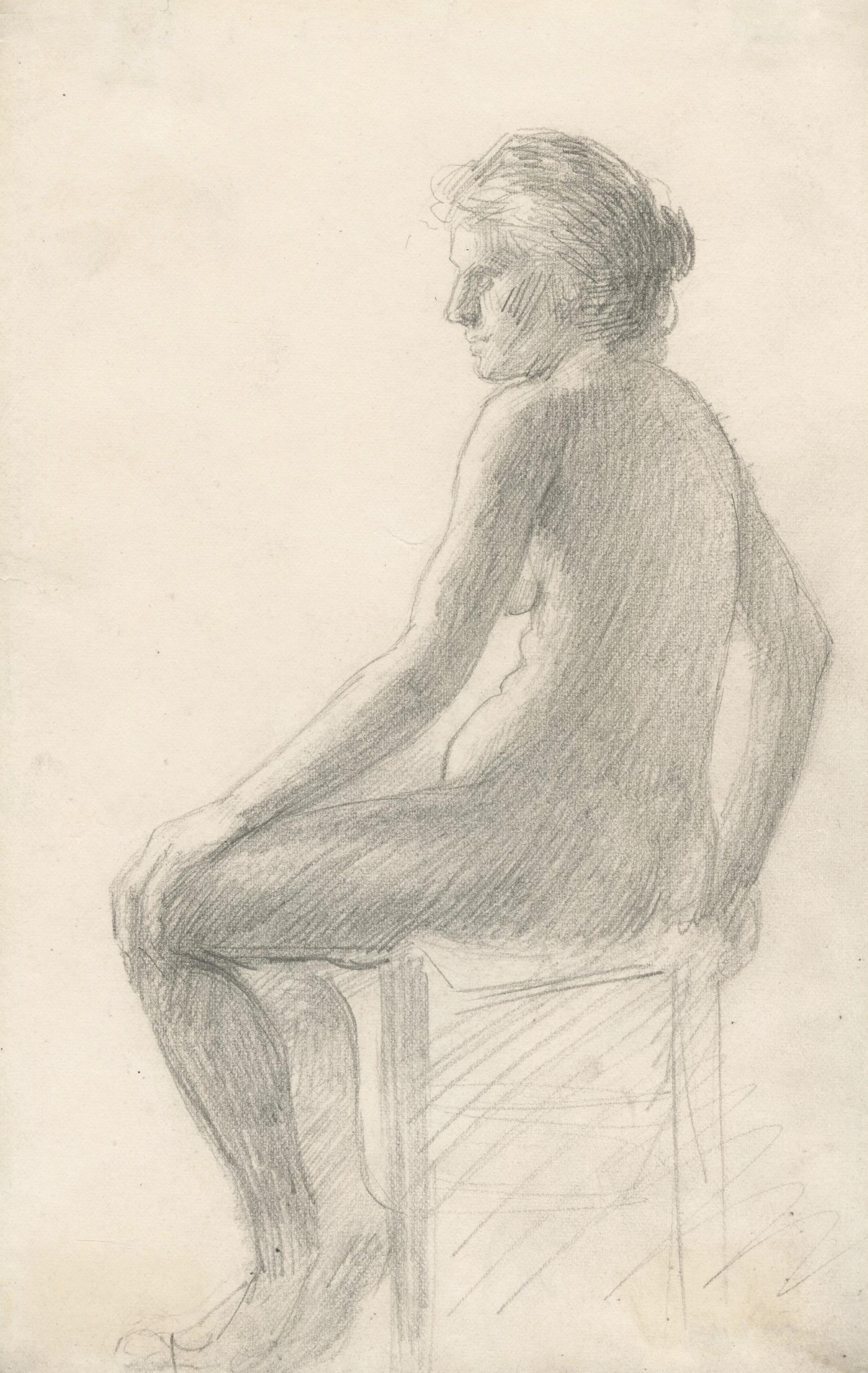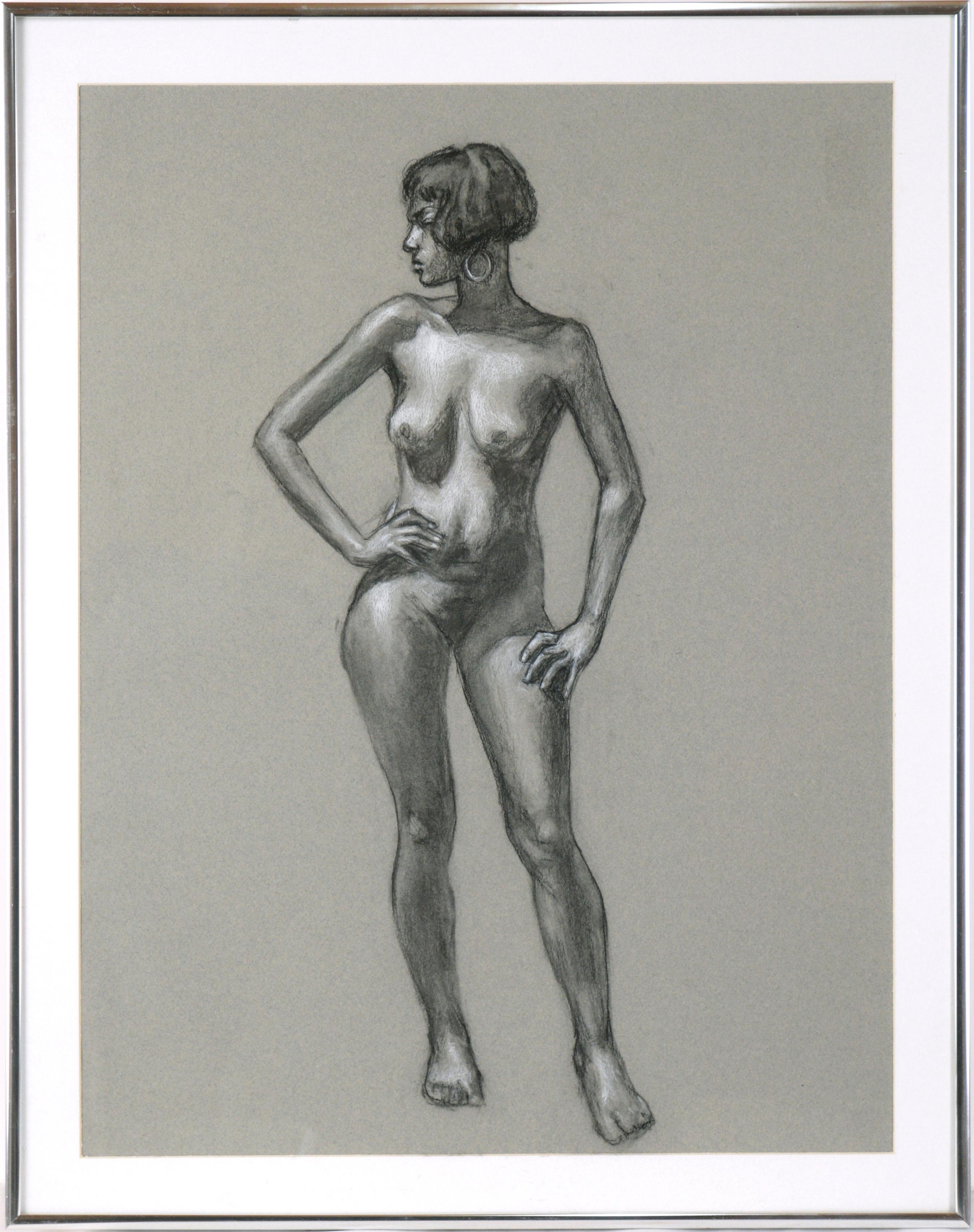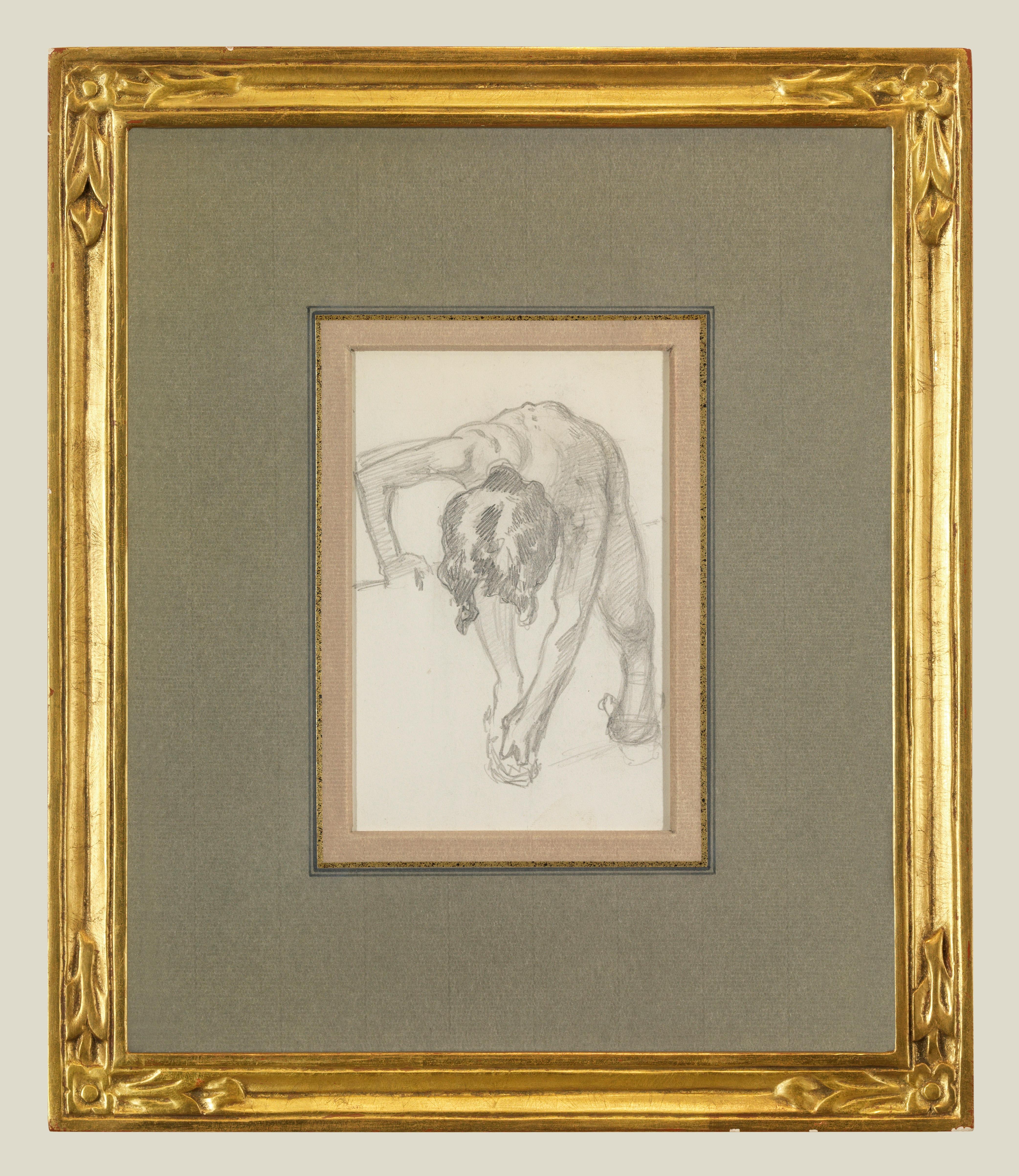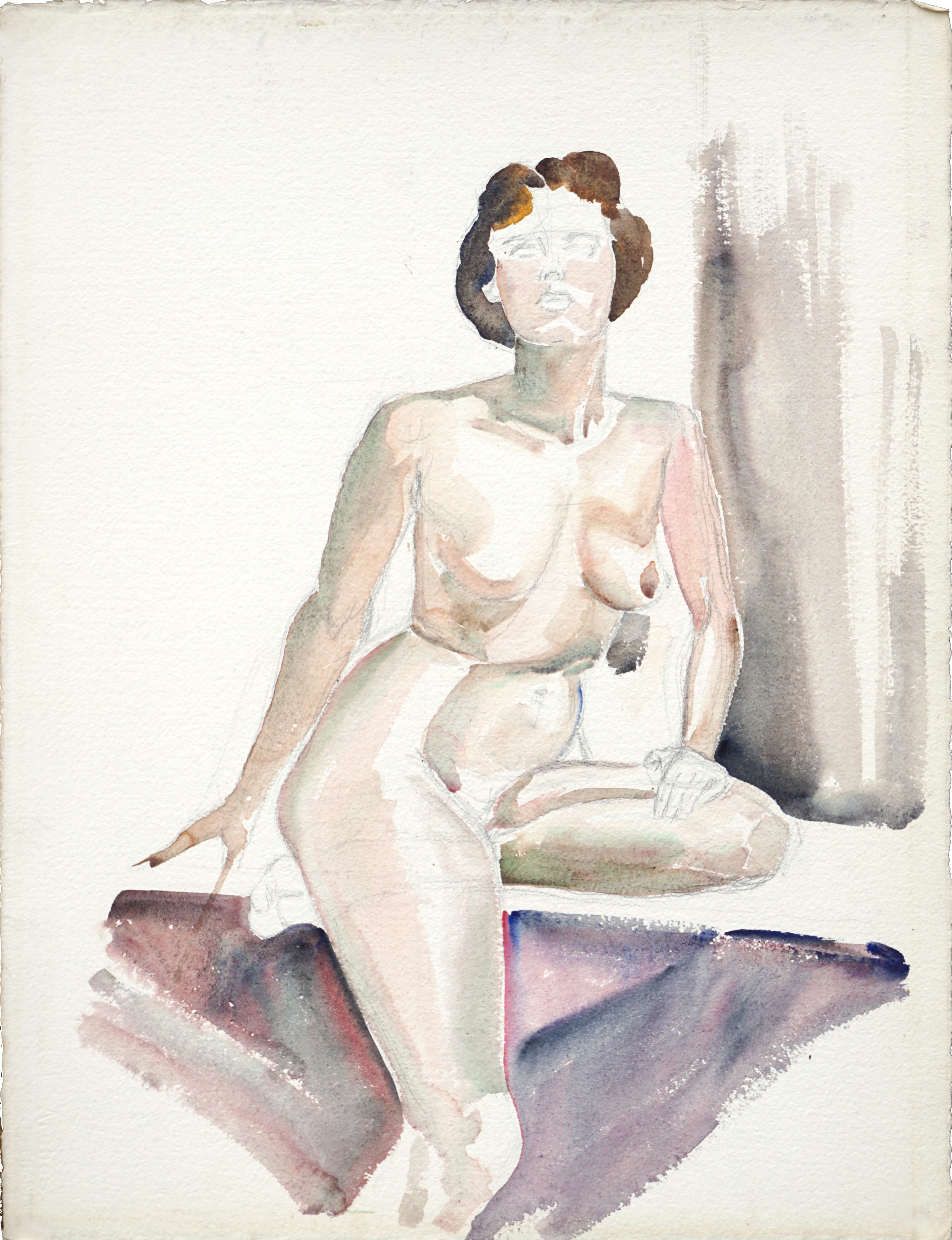Items Similar to Standing Male Nude (recto) Study of the Head of the Standing Male Nude (verso)
Want more images or videos?
Request additional images or videos from the seller
1 of 15
William Merritt ChaseStanding Male Nude (recto) Study of the Head of the Standing Male Nude (verso)c. 1875
c. 1875
About the Item
Standing Male Nude (recto)
Study of the Head of the Standing Male Nude (verso)
Unsigned
Provenance:
Estate of the artist
Helen Chase Storm (the artist's daughter)
Jackson Chase Storm (the artist's grandson)
Baker-Pisano Collection (the author of the William Merritt Chase Catalog Raisonne Project)
References And Exhibitions:
Pisano D8, reproduced p. 183
Rare. Chase did relatively few drawings, probably no more than 150 in total, according to the catalogue raisonne.
William Merritt Chase (1840-2016)
Born in Nineveh, Indiana Died New York, New York
In 1883 Chase was involved in the organization of an exhibition to help raise funds for a pedestal for the Statute of Liberty. The exhibition featured loans of three works by Manet and urban scenes by the Italian Impressionist Giuseppe de Nittis. Both artists influenced Chase's Impressionistic style that gave rise to a series of New York park scenes. It is also thought that he was influenced by John Singer Sargent's In the Luxembourg Gardens (1879) which was exhibited in New York at this time. Indeed, Chase had met Sargent in Europe in 1881, the two men becoming lifelong friends with Sargent painting Chase's portrait in 1902.
On another European trip in 1885, Chase met James McNeill Whistler in London. While Whistler had a reputation for being difficult, the two artists got along famously and agreed to paint one another's portrait. Eventually, however, Whistler's moods began to grate with Chase who wrote home stating "I really begin to feel that I never will get away from here". For his part, Whistler criticized Chase's finished portrait and, according to Hirshler, "complained about Chase for the rest of his life". While no record exists of Whistler's portrait of Chase; Chase's portrait of Whistler remains a well-known piece in his oeuvre.
In 1887 Chase married Alice Gerson, the daughter of the manager of a lithography company. Though some fifteen years his junior (Chase was 37), he had known Alice for some time through her family's devotion to the arts. The pair, who would enjoy a happy marriage with Alice in full support of her husband's career, settled initially in Brooklyn where their first child was born. The couple would parent six daughters and two sons and it was only his family that could rival his devotion to his art. Indeed, Chase often combined his two loves by painting several portraits of his wife and children in Brooklyn parks before the couple relocated to Manhattan.
Later Period
Between 1891 and 1902, Chase and his family spent their summers at a purpose-built home and studio in Shinnecock Hills, a close suburb of the upmarket town of Southampton on the south shore of Long Island (roughly 100 miles east of New York). Chase set up, and taught two days a week, at the nearby Shinnecock Hills Summer School of Art which benefitted from the financial backing of local art collectors. It was at Shinnecock that Chase, taken in by the region's striking natural surroundings, painted several Impressionistic landscapes. As Bettis put it, "There, among the dunes, in the bright sunlight and sea air his painterly impulse was given free sway, and he produced some of his freest and loveliest work". His passion for the area was so felt he even gave his daughter Hazel the middle name of Neamaug, in honor of the rich Native American history of Shinnecock. Chase was equally focused on the students that came to the School and who he encouraged to paint in the modern plein air style favored by the French Impressionists.
Although Chase was making a name for himself as an Impressionist, he never abandoned his commitment to the sombre tones and academic tropes he had learned in Munich, though these he reserved for his portraits, and for his series of striking still lifes featuring dead fish. Chase was in fact a successful society portraitist - he painted fashionable women for a fee of $2,000 - and would paint his students as "samples" which he then donated to leading art institutions (such as Lady in Black (1888) which he donated to the Metropolitan Museum in 1891).
In 1896, facing financial difficulties, Chase flirted with the idea of giving up his teaching in New York and traveled with his family to Madrid where he developed a passion for bullfighting. Chase returned however to Shinnecock in June to teach his yearly summer art class, and in the fall of that year, established his own art school in Manhattan: the Chase School which was modelled on the Académie Julian in Paris. Chase lacked business savvy, however, and the Chase School lasted only two years before it was placed under new management. It continued as the New York School of Art (changed to Parsons School of Design starting 1941) with Chase as head the School for eleven more years. Chase also taught during this period at the Pennsylvania Academy of Fine Arts.
In 1902, following the premature death of his friend John Twachtman, Chase was invited to join the Ten American Painters group (who included amongst its members, Frank Weston Benson, Thomas Wilmer Dewing, Robert Reid and Julien Alden Weir) with whom he continued to exhibit for the remainder of his career. Like Chase, the other group members were committed to the philosophy of Eclecticism. As the art historian Isabel L. Taube described it, Eclecticism amounted to more than just a "jumble of sources" and depended rather on "clear intention and reason instead of chance and intuition". She adds that by the late nineteenth century "discussions of eclecticism in popular magazines and trade publications emphasized the difficult and serious study required to achieve a harmony of diverse elements in architecture as well as the fine and decorative arts".
Though he painted and exhibited until his death in 1916, in this later years Chase devoted more and more time to teaching, dividing his time between Europe and America. Between 1902 and 1913 he spent his summers travelling to Europe where he taught classes in Belgium, England, Italy, Holland and Spain. His last European class was held in Venice in the summer of 1913. Chase had also taken great pride in the studio set up he established at Fourth Avenue in 1908. Here he taught private classes while continuing to work enthusiastically on his own paintings. He maintained his association with the Art Students League of New York until 1912 and, in 1914, he experienced a new teaching environment by conducting summer classes on the West Coast in Carmel, California. During the winter of 1916, Chase began to feel unwell. Though he continued to paint, he grew increasingly ill from what was diagnosed as cirrhosis of the liver. Forced to cut short a visit to Atlantic City, Chase returned to New York where he died two days later aged just sixty-six.
The Legacy of William Merritt Chase
Chase had a profound impact on shaping the development of modern art in the United States. As curator Erica Hirshler explains, "Chase developed an American version of Impressionism to depict modern subjects" and started incorporating other modern artmaking techniques in the way he "often employed daringly abstract compositions, devising interlocking patterns of vertical and horizontal lines or dramatic diagonal sweeps that provided a firm geometric foundation for his loose strokes of color". She adds that he "also experimented with different media and was an innovator in the revival of painting in pastel". Indeed, according to the Phillips Collection website, as "co-founder of the progressive Society of American Painters in Pastel, Chase was a leader in the late 19th-century revival of pastel painting and one of its most innovative practitioners".
Chase also created an impressively important legacy as an art teacher. While the notion of plein air painting had been embraced by the French Impressionists, Chase led the way in importing that approach to America; both through the example of his own works but also by encouraging his students to engage in the practice as well. Unlike some instructors who required students to mimic their own methods, Chase chose simply to encourage his students to explore their own artistic paths. As Hirshler explains, "perhaps Chase's success as a teacher is marked by the fact that only some of his students followed his stylistic example; others - among them Lydia Field Emmet, Rockwell Kent, Marsden Hartley, Edward Hopper, Charles Sheeler, and Georgia O'Keeffe - used what they learned in his classes as a springboard for their own artistic innovations". He was also considered a trailblazer in his appreciation of women artists. As author Christina Michelon explains, "Chase's modern thinking extended to [...] his mentoring of female students.
Courtesy of The Art Story
- Creator:William Merritt Chase (1849-1916, American)
- Creation Year:c. 1875
- Dimensions:Height: 15 in (38.1 cm)Width: 10 in (25.4 cm)
- Medium:
- Movement & Style:
- Period:
- Condition:Extremely RARE.
- Gallery Location:Fairlawn, OH
- Reference Number:
About the Seller
5.0
Recognized Seller
These prestigious sellers are industry leaders and represent the highest echelon for item quality and design.
Platinum Seller
These expertly vetted sellers are 1stDibs' most experienced sellers and are rated highest by our customers.
Established in 1978
1stDibs seller since 2013
711 sales on 1stDibs
Typical response time: 1 hour
Associations
International Fine Print Dealers Association
- ShippingRetrieving quote...Ships From: Fairlawn, OH
- Return PolicyA return for this item may be initiated within 10 days of delivery.
More From This SellerView All
- Side View Seated Female NudeBy Frank DuveneckLocated in Fairlawn, OHSide View Seated Female Nude Graphite on paper, c. 1890's Unsigned Provenance: Rookwood Pottery Factory Collection, Cincinnati Spanierman Gallery, New York (label) Drawings from the sketchbook are in the collections of the Munson Williams Proctor Institute in Utica, New York and the Picker Art Gallery, Colgate University, Hamilton, New York. Condition: Excellent Sheet size: 9 1/4 x 6 1/4 inches Frame size: 16 x 12 1/2 inches Frank Duveneck (1848-1919) Born in Covington, Kentucky, Frank Duveneck had the birth name of Frank Decker. He became a well-trained academic painter whose work ranged from single figures in interiors to plein air canvases of figures in landscape and often included the depiction of low-life persons. His styles included Realism, Social Realism, and Impressionism, and his work was ever influenced by the dark tones and vigorous brush-strokes of the Munich style, which he learned at the Munich Academy in the 1870s. Art historian Matthew Baigell described Duveneck's mature style as having "loose highlights brushed over ruggedly blocked-out forms emerging from a richly suggestive chiaroscuro." He apprenticed to a church decorator, Wilhelm Lamprecht, in Cincinnati, and worked in Catholic Churches in Covington, Cincinnati, Latrobe, Pennsylvania and Quebec, Canada. At age 22, entered the Royal Academy of Munich where he intended to further his interest in church decoration but instead veered to fine-art painting on canvas. One of his most influential teachers was realist Wilhelm von Diez, and Duveneck, also impressed by the realism of French painter Gustave Courbet, became known for adopting this revolutionary approach with rich brushwork. In Munich, Duveneck shared a studio with William Merritt Chase. Returning to Cincinnati, he painted portraits and decorated churches and also taught art classes. At first he did not gain much attention, but an exhibition in Boston in 1875 gained him good attention. In 1875, he went back to Europe and opened an art school in Munich and also in Poling in Bavaria, and many Americans who became known as "Duveneck's Boys," studied with him. Several years later, he opened his school in Italy where he spent the winters in Florence and the summers in Venice. In 1879, he and his followers went to Venice where he began etching and briefly shared a studio with James Whistler in order to learn from him. He also did sculpture. During this period, his painting changed drastically from dark interiors with heavy, impasto paint to outdoor, plein air painting in much lighter colors giving the appearance of sunlight. Among his students was the future Impressionist painter John Henry Twachtmann, and also Elizabeth Boott, whom he married in 1886 and who died two years later. In 1888, he returned to Cincinnati where from 1900 he taught at the Cincinnati Art Academy. He spent the summers in Gloucester, Massachusetts painting...Category
1890s American Impressionist Nude Drawings and Watercolors
MaterialsGraphite
- Three Nudes in a GardenBy Aaron BohrodLocated in Fairlawn, OHThree Nudes in a Garden Graphite, c. 1928-1933 Initialed in pencil lower left (see photo) Illustrated: Elliott & Wooden, Aaron Bohrod: Figure Sketches, Fige 9, page 32 (see photo) A...Category
1920s American Modern Nude Drawings and Watercolors
MaterialsGraphite
- Untitled (seated female nude)By Henry KellerLocated in Fairlawn, OHSeated Femake Nude Graphite and chalk on tan paper, c. 1920 Signed "Keller" and signed again with the artist's initials in a cypher A finished life drawing most probably exhibited at...Category
1920s American Modern Nude Drawings and Watercolors
MaterialsGraphite
- Untitled (Two Standing Nudes, one seated nude)By Boris Lovet-LorskiLocated in Fairlawn, OHUntitled (Two Standing Nudes, one seated nude) Graphite on wove paper, heightened with color, c. 1930 Unsigned From a sketchbook created while the artist was working in Paris Condition: Very good Provenance: Estate of the Artist Dawson's Auction, Morris Plains, NY, 2001 Boris Lovet-Lorski Lithuanian/Russian/American 1894-1973 Sculptor, painter, and printmaker, Boris Lovet-Lorski was born in Lithuania in 1894. His mother died when he was age three. His father was affluent and owned real estate. Boris grew up in a privileged environment. He studied architecture and then fine arts at the Imperial Academy of Art in Petrograd, Russia (now Saint Petersburg). Following the revolution in 1917 and its aftermath, Boris immigrated to Boston to live with his brother. In the 1920’s, his stylized, Art Deco inspired sculptures, lithographs, and paintings proved to be popular among the American elite. He exhibited frequently, holding his first solo exhibition in Boston, 1920. In the following years, Boris exhibited in New York at Marie Sterner Gallery, Jacques Seligmann Galleries and Wildenstein and Company. He lived in Paris from 1926 to 1932 where he befriended Joseph Hecht, and was exposed to the works of Pablo Picasso, Ossip Zadkine, Contantin Brancusi and Aristide Maillol. In 1932 he returned to America where he became a citizen later in the decade. Lovet-Lorski exhibited in the United States, South America, Europe and Asia. He was a member of the Society of Independent Artists (New York), the National Academy of Design (New York), and the Lotos Club (New York), as well as several Parisian salons. His work is in the permanent collections of numerous museums including the Musée Luxembourg, Bibliotèque Nationale, and the Petit Palais in France, the British Museum in London, the Metropolitan Museum in New York, the National Gallery in Washington, the Los Angeles County Museum of Art. (A more extensive list of his works in museums follows) He is considered one of the most successful and recognized sculptors of his generation. His creative influence can be seen in many of his contemporary artists. He died in Los Angeles in 1973. Regarding his iconic Art Deco sculptures of Cretan Dancers: “The stylizing of the Cretan allegories, used in figures of animals such as horses and bulls, symbolizes the ancient power of the South. These figures reveal a spiritual sensuality as he strives to attain a symbol of the earth and universe endowed with musical values. If man is the center of his idea of life and nature, it is because of the laws that govern the movement of stars and history. The link binding his figures together has, in a sense, a Pythagorean harmony.” Salvatore Quasimodo, Milan, 1967, quoted from Bush, Boris Lover-Lorski: The Language of Time, page 12. Lovet-Lorski created sculptures of the following major figures I.J. Paderewski, Prime Minister of Poland Arturo Toscanini, Italian Conductor Lilian Gish, Actress President Franklin D. Roosevelt Mrs. M. C. Niarchos, wife of Stavros Niarchos President Abraham Lincoln James Forrestal, Secretary of the Navy, First Secretary of Defense Pope Pius XII Dr. Albert Einstein, theoretical physicist President Dwight D. Eisenhower Albert Schweitzer, theologian, organist, writer, humanitarian, philosopher, and physician General Charles De Gaulle, President of the Fourth and Fifth Republic, France John Foster Dulles, Secretary of State, 1953-1959 President John F. Kennedy Works by Lover Lorski are in the following public collections: Albright-Knox Art Gallery, Buffalo Art Institute of Chicago Bibliotheque Nationale, Paris Brandeis University, Waltham, MA British Museum, London Boston University Brooklyn Museum California Palace of the Legion of Honor, Sam Francisco...Category
1930s Art Deco Nude Drawings and Watercolors
MaterialsGraphite
- Preliminary Study for Cretan Dancer BronzeBy Boris Lovet-LorskiLocated in Fairlawn, OHPreliminary Study for Cretan Dancer Bronze Graphite on tracing paper, 1930 Unsigned Note: The bronze sculpture measures 24 1/2 x 33 5/8 inches and is signed and dated 1930 on the base (see image on right). It is currently being offered for sale by Taylor Graham Gallery in New York. (see photo) “The stylizing of the Cretan allegories, used in figures of animals such as horses and bulls, symbolizes the ancient power of the South. These figures reveal a spiritual sensuality as he strives to attain a symbol of the earth and universe endowed with musical values. If man is the center of his idea of life and nature, it is because of the laws that govern the movement of stars and history. The link binding his figures together has, in a sense, a Pythagorean harmony.” Salvatore Quasimodo, Milan, 1967, quoted from Bush, Boris Lover-Lorski: The Language of Time, page 12. Image size: 6 1/2 x 6 1/2 inches Condition: Repaired tear in the lower left corner (see detail photo) Boris Lovet-Lorski Lithuanian/Russian/American 1894-1973 Sculptor, painter, and printmaker, Boris Lovet-Lorski was born in Lithuania in 1894. His mother died when he was age three. His father was affluent and owned real estate. Boris grew up in a privileged environment. He studied architecture and then fine arts at the Imperial Academy of Art in Petrograd, Russia (now Saint Petersburg). Following the revolution in 1917 and its aftermath, Boris immigrated to Boston to live with his brother. In the 1920’s, his stylized, Art Deco inspired sculptures, lithographs, and paintings proved to be popular among the American elite. He exhibited frequently, holding his first solo exhibition in Boston, 1920. In the following years, Boris exhibited in New York at Marie Sterner Gallery, Jacques Seligmann Galleries and Wildenstein and Company. He lived in Paris from 1926 to 1932 where he befriended Joseph Hecht, and was exposed to the works of Pablo Picasso, Ossip Zadkine, Contantin Brancusi and Aristide Maillol. In 1932 he returned to America where he became a citizen later in the decade. Lovet-Lorski exhibited in the United States, South America, Europe and Asia. He was a member of the Society of Independent Artists (New York), the National Academy of Design (New York), and the Lotos Club (New York), as well as several Parisian salons. His work is in the permanent collections of numerous museums including the Musée Luxembourg, Bibliotèque Nationale, and the Petit Palais in France, the British Museum in London, the Metropolitan Museum in New York, the National Gallery in Washington, the Los Angeles County Museum of Art. (A more extensive list of his works in museums follows) He is considered one of the most successful and recognized sculptors of his generation. His creative influence can be seen in many of his contemporary artists. He died in Los Angeles in 1973. Regarding his iconic Art Deco sculptures of Cretan Dancers: “The stylizing of the Cretan allegories, used in figures of animals such as horses and bulls, symbolizes the ancient power of the South. These figures reveal a spiritual sensuality as he strives to attain a symbol of the earth and universe endowed with musical values. If man is the center of his idea of life and nature, it is because of the laws that govern the movement of stars and history. The link binding his figures together has, in a sense, a Pythagorean harmony.” Salvatore Quasimodo, Milan, 1967, quoted from Bush, Boris Lover-Lorski: The Language of Time, page 12. Lovet-Lorski created sculptures of the following major figures I.J. Paderewski, Prime Minister of Poland Arturo Toscanini, Italian Conductor Lilian Gish, Actress President Franklin D. Roosevelt Mrs. M. C. Niarchos, wife of Stavros Niarchos President Abraham Lincoln James Forrestal, Secretary of...Category
1930s Art Deco Nude Drawings and Watercolors
MaterialsGraphite
- Untitled Female NudeBy Steven AssaelLocated in Fairlawn, OHUntitled (Female Nude) Graphite and sgrafitto on yellow paper, 1987 Signed lower right Note: Steven Assael is represented by Forum Gallery in New York. In 1977 he won the Charles Ro...Category
1980s American Realist Nude Drawings and Watercolors
MaterialsGraphite
You May Also Like
- Studies for MedusaBy John Singer SargentLocated in New York, NYImage size: 16 x 20 ½ inches This is a study for the body of Medusa in Perseus on Pegasus Slaying Medusa, 1922-25, the mural panel installed on the ceiling side aisle of the Hunting...Category
1920s American Impressionist Nude Drawings and Watercolors
MaterialsPaper, Charcoal, Graphite
- "Standing Figure" Nude in Charcoal and Color Pencil on PaperBy George WishonLocated in Soquel, CA"Standing Figure" Nude in Charcoal and Color Pencil on Paper Beautiful modern figure drawing of a nude woman by Bay Area Artist George Wishon (A...Category
Late 20th Century American Impressionist Nude Drawings and Watercolors
MaterialsPaper, Pastel, Color Pencil
- "Seated Figure" Nude in Pastel and Color Pencil on PaperBy George WishonLocated in Soquel, CA"Seated Figure" Nude in Pastel and Color Pencil on Paper Beautiful modern figure drawing of a nude woman by Bay Area Artist George Wishon (Ameri...Category
Late 20th Century American Impressionist Nude Drawings and Watercolors
MaterialsPaper, Pastel, Color Pencil
- Figure Bending OverBy John Singer SargentLocated in New York, NYImage dimensions: 5 ½ x 3 ½ inches Framed dimensions: 12 ⅛ x 10 ⅜ inches Inscribed at lower left: JS 220 Our drawing is also referred to as Young Boy Adjusting His Sandal, and is illustrated in the catalogue for Sargent's 1928 exhibition of drawings at Grand Central Art Galleries in New York. It is an example of an early study from life executed c. 1874-8.* Sargent drew continuously from an early age and had benefited from the emphasis on drawing at the Accademia delle Belle Arti in Florence where he entered the life class in 1870. He arrived in Paris on May 16th, 1874, with a large portfolio of drawings...Category
1870s American Impressionist Figurative Drawings and Watercolors
MaterialsPaper, Pencil
- Mid Century Seated Nude Figure Study (unfinished)By Joseph YeagerLocated in Soquel, CASeated nude figure study by Joseph Yeager (American, 20th Century). This piece is unsigned, but was acquired with a collection of Yeager work directly from the estate. This piece is on heavy bond paper with ragged edges and is unfinished. No frame. Joseph "Joe" Yeager (American, 20th Century) was raised in Cleveland Ohio, where he went to art school at night and started his art career at 19. He was a commercial artist for the Cleveland Press...Category
1960s American Impressionist Nude Drawings and Watercolors
MaterialsPaper, Watercolor, Pencil
- English Graphite Portrait Sketch of Female Nude, StandingBy Henry George MoonLocated in Cirencester, GloucestershireEnglish Graphite Sketch of a Female Nude, Standing by Henry George Moon (British 1857-1905) on off-white artists paper, unframed measurements: sheet 14.5 x 11 inches provenance: fr...Category
Late 19th Century Impressionist Nude Drawings and Watercolors
MaterialsGraphite
Recently Viewed
View AllMore Ways To Browse
The Head
Study For The Collector
The Shape Of Her
Antique Chase
Along The Lines
Male Study
Collection Of Architectural Drawings
Architectural Drawing Study
Set Of Architectural Studies
Art Of The Sixties
Male Nudes
Male Nuders
Head Study Painting
The Nude Male
Society Of Six
Free Standing Art
Plein Air Style
Thoughts Of Home





